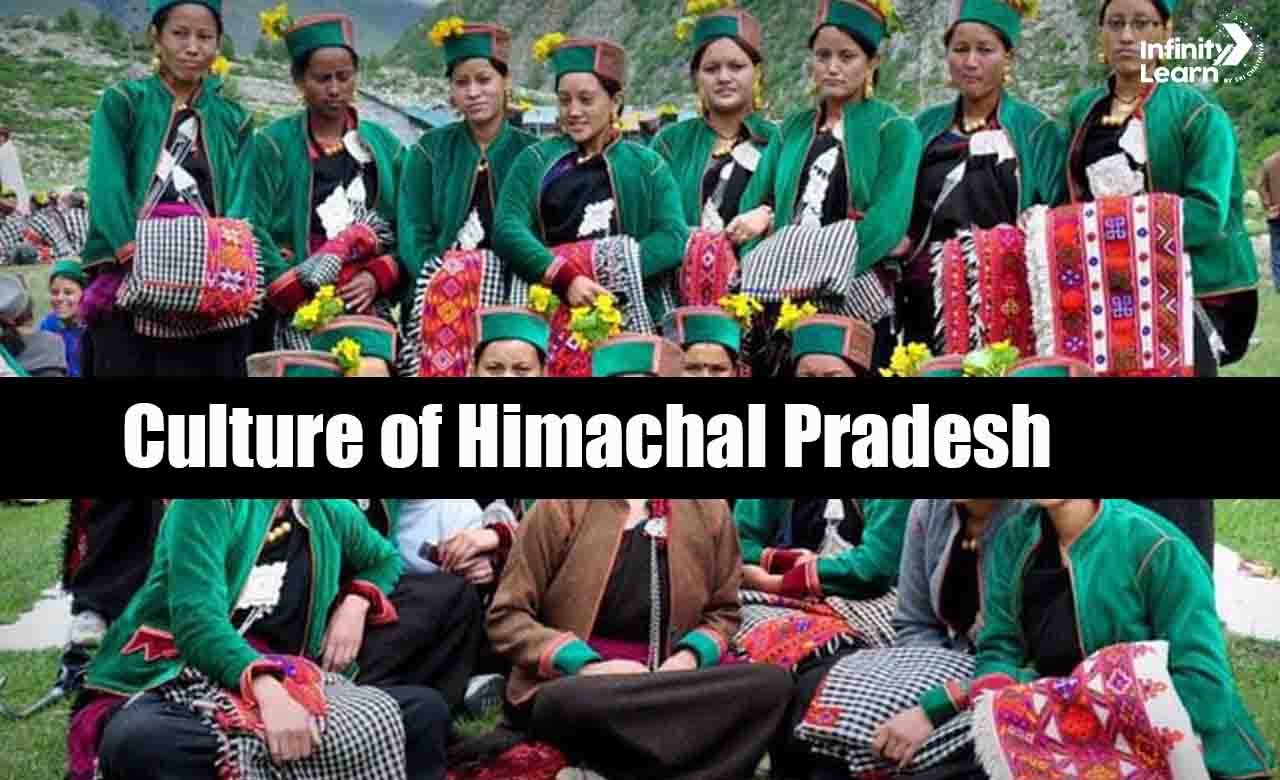Table of Contents
The culture of Himachal Pradesh is a rich tapestry of traditions, languages, and religions, largely untouched by Western influence. This North Indian state is a multi-religion, multicultural, and multilingual region. Hindi and various Pahari languages are commonly spoken here. The Hindu communities in Himachal include Brahmins, Rajputs, Kannets, Rathis, and Kolis. The tribal population consists mainly of Gaddis, Kinnars, Gujjars, Pangawals, and Lahaulis.
Languages and Communities
- Languages: Hindi and various Pahari languages are commonly spoken.
- Hindu Communities: Brahmins, Rajputs, Kannets, Rathis, and Kolis.
- Tribal Populations: Gaddis, Kinnars, Gujjars, Pangawals, and Lahaulis.

Arts and Crafts of Himachal Pradesh
Himachal Pradesh culture is renowned for its vibrant arts and crafts. The state produces exquisite carpets, leather works, shawls, paintings, metalware, and woodwork. The Pashmina shawl, in particular, is highly sought after both within Himachal and across India. The colorful Himachali caps are another famous artwork from the region. The Dom tribe excels in crafting bamboo items like boxes, sofas, chairs, baskets, and racks. Metalware includes utensils, ritualistic vessels, idols, and gold and silver jewelry.
Also Check: Capital of Himachal Pradesh
Handicrafts:
- Common Items: Carpets, leather works, shawls, paintings, metalware, and woodwork.
- Specialty: Pashmina shawl.
- Tribal Expertise: Dom tribe excels in bamboo items.
| Item | Description |
|---|---|
| Carpets | Handwoven with intricate designs. |
| Leather Works | High-quality leather products. |
| Shawls | Famous for Pashmina and vibrant Himachali caps. |
| Metalware | Includes utensils, ritual vessels, idols, jewelry. |
| Woodwork | Items like boxes, frames, and idols. |
Music and Dance in Himachal Pradesh
Music and dance are integral to the culture of Himachal Pradesh. These art forms are used to praise gods during festivals and special occasions. Each region has its unique dance forms, such as Losar Shona Chuksam in Kinnaur, Dangi in Chamba, Gee Dance and Burah Dance in Sirmour, and Naati, Kharait, Ujagjama, and Chadhgebrikar in Kullu. The main dance form of Himachal Pradesh is Naati. Folk music is preferred, with no classical music tradition in the state. These dance forms reflect the rich cultural heritage and are essential parts of local festivities.
Regional Dance Forms:
- Kinnaur: Losar Shona Chuksam
- Chamba: Dangi
- Sirmour: Gee Dance and Burah Dance
- Kullu: Naati, Kharait, Ujagjama, Chadhgebrikar
- Lahaul & Spiti: Shunto
Main Dance Form: Naati
Music:
- Folk Music: Preferred over classical music.
- Dance: Essential part of festivals and celebrations.
Festivals and Fairs in Himachal Pradesh
Himachal Pradesh culture is marked by numerous fairs and festivals. Each region has temple fairs that hold great significance. Major festivals include Kullu Dussehra, Shivratri Fair in Mandi, Shoolini Mela in Solan, Minjar Fair and Mani Mahesh Chhari Yatra in Chamba, Renuka Fair in Sirmaur, Lavi Trade Fair in Rampur, Vrajeshwari Fair in Kangra, Jwalamukhi Fair in Jwalamukhi, Holi Fair in Sujanpur Tira, and Naina Devi Fair in Bilaspur. The Sair festival, celebrated in Shimla, Kangra, Mandi, Kullu, and Solan districts in mid-September, marks the end of the crop harvest.
| Festival/Fair | Description | Timing |
|---|---|---|
| Chintpurni Fair | Celebrates Chintpurni Mata with dance, music, and religious chants. | March-April, July-August, September-October |
| Renuka Fair | Celebrates Vishnu and Renuka with a grand procession. | November |
| Chessu Fair | Buddhist fair commemorating Guru Padma Sambhava. | March |
| Jwalamukhi Fair | Celebrates the eternal flame with rituals and folk dances. | October, March |
| Sui Fair | Exclusively for women, celebrating at Sunaina Rani Temple. | April |
| Lavi Fair | Trade fair promoting Indo-Tibet trade relations. | November |
Traditional Food of Himachal Pradesh
The daily diet in Himachal Pradesh is similar to that of North India, featuring lentils, broth, rice, vegetables, and bread. Non-vegetarian dishes are more popular here compared to other North Indian states. Traditional Himachali cuisine includes dishes with thick and rich gravies made with aromatic spices. Dham, served at marriages and functions, is a traditional meal. Specialties include Manee, Madra, Palda, Redu, Patrode, Chouck, Bhagjery, and til chutney. Snacks like Siddu, Patrode, Cheele, Tudkiya Bhath, and Babru are also popular. Steamed momos and noodles are now common and popular among travelers.
Daily Diet:
- Common Foods: Lentils, broth, rice, vegetables, bread.
- Non-Vegetarian Cuisine: Preferred compared to other North Indian states.
Special Dishes:
| Dish | Description |
|---|---|
| Dham | Traditional meal served at functions. |
| Siddu | Steamed bread. |
| Patrode | Colocasia leaf rolls. |
| Cheele | Pancake-like dish. |
| Tudkiya Bhath | Spiced rice dish. |
| Babru | Fried bread. |
| Chutney of Til | Sesame seed chutney. |
People and Traditional Attire
Himachal Pradesh culture is predominantly Hindu, with major communities including Brahmins, Rajputs, Choudharies, Kannets, Rathis, and Kolis. The tribal population consists of Gaddis, Kinnars, Jaduns, Tanolis, Gujjars, Pangawals, and Lahaulis. The Kinnars practice polyandry and polygamy, while Gujjars are nomadic and primarily Muslim. The Lahaulis in Lahaul and Spiti and natives of Kinnaur are mostly Buddhists, and there is also a significant Tibetan population.
Hindi is the state language, though many speak Western Pahari languages. While agriculture is the main occupation, educated individuals are increasingly moving towards tertiary sectors. Traditional male attire for Brahmins includes dhoti, kurta, coat, waistcoat, turban, and a hand towel, while Rajputs wear churidar pyjamas, long coats, and starched turbans. However, Western-style clothing is now prevalent.
Typical houses are made of clay bricks with slate roofs, although timber roofs are also used in some areas.
Communities:
- Hindus: Brahmins, Rajputs, Choudharies, Kannets, Rathis, and Kolis.
- Tribal Populations: Gaddis, Kinnars, Jaduns, Tanolis, Gujjars, Pangawals, and Lahaulis.
Occupations:
- Primary: Agriculture.
- Secondary: Tertiary sectors for educated individuals.
Traditional Dress:
- Brahmin Male: Dhoti, kurta, coat, waistcoat, turban, hand towel.
- Rajput Male: Churidar pyjamas, long coat, starched turban.
- Modern Influence: Increasing preference for Western-style clothing.
Housing:
- Construction: Clay bricks, slate or timber roofs.
| Culture of Manipur | Culture of Bihar |
| Culture of Assam | Culture of Andaman and Nicobar Islands |
| Culture of Rajasthan | Culture of Odisha |
| Culture of Kerala | Culture of Telangana |
FAQs on Culture of Himachal Pradesh
What are the cultures in Himachal Pradesh?
The Culture of Himachal Pradesh is diverse, with people practicing multiple religions and speaking various languages. Commonly spoken languages include Hindi and different Pahari languages. Hindu communities in Himachal Pradesh include Brahmins, Rajputs, Kannets, Rathis, and Kolis.
What is the dress and culture of Himachal Pradesh?
The traditional dress of Himachal Pradesh, known as the 'Kulluvi' or 'Pahari' dress, is made from warm woolen fabric, ideal for the cold climate. The dress includes a long shirt called 'Kameez' and loose pants called 'Salwar', reflecting the practical and cultural aspects of Himachal Pradesh Culture.
Which is the cultural festival in Himachal Pradesh?
One of the major festivals in Himachal Pradesh is Kullu Dussehra. This significant festival is celebrated every October with a grand fair at Dhalpur Maidan in the Kullu valley. Known as an international fair, it attracts thousands of tourists each year, highlighting the vibrant Culture of Himachal Pradesh.
What makes Himachal Pradesh famous?
Himachal Pradesh is known for its stunning scenery, vibrant culture, and adventure activities. Popular among tourists, Himachal Pradesh Culture offers beautiful hill stations and exciting activities like trekking and skiing.
What is the cultural capital of Himachal Pradesh?
Mandi, often called 'Chotti Kashi', is considered the cultural capital of Himachal Pradesh. It resembles Varanasi with its Ghats on the Beas River and numerous Lord Shiva temples. Mandi is known for its rich traditions and temple architecture, showcasing the deep-rooted Himachal Pradesh Culture.
What is the traditional food of Himachal Pradesh?
A traditional dish in Himachal Pradesh is Dhaam, a meal that includes dal, rajma, rice, curd, boor ki Kadi, and jaggery (gur). Dhaam is not only tasty but also nutritious, representing the wholesome nature of Himachal Pradesh Culture.









